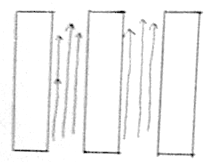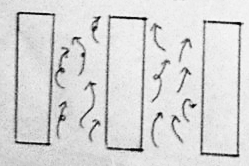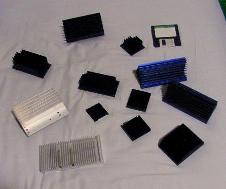




I added this section because there was some confusion as to what makes a good heat sink. Especially in the overclocker community, people often tend to buy heat sinks purely based on size and surface area, as opposed to good engineering and actual cooling ability. In practice, the optimal heat sink will almost never have the largest area, and will often times not be the largest. Heat sinks are designed for a specific amount of air flow, so ones made fanned operation are usually poor at fanless and vica versa.

|

|
| Fins spaced too closely trap air. With almost no airflow, the air heats up, and the processor stays warm. | Fins spaced slightly further apart only allow for laminar airflow. The air layer near the fins heats up as it passes, but since the same layer stays in contact with the heat sink, by the time it exits it is almost the temperature of the fins. Meanwhile, the air layer in the middle stays cool. This also does not cool the heat sink very efficently. |

|
 |
| Spaced even further apart, airflow becomes turbulent. The turbulent flow keeps the air a consistent temperature throughout, and so cools the heatsink most efficiently. | However, once the fins are spaced too far apart, although we have excellent airflow, we now have limited surface area over which to cool the sink, and so we again lose efficency. |
For convection-cooled (fanless) heatsinks, we rely on warm air rising to provide the airflow. Obviously, this gives much less airflow than having a fan actively blowing on the sink. To make up for it, we need much wider fin spacing. Most convection heat sinks have fin spacing on the order of a quarter inch.
If you have a tower case, it is also important that you mount the fanless heat sinks with the fins vertically instead of horizontally. Convection causes hot air to flow up, and horizontal fins would restrict air flow. Many large heat sinks are circular, and designed to efficently route airflow from a fan. These are, obviously, bad choices for fanless operation.
There is also a maximum size beyond which enlarging a heat sink helps very little. While this limit is often hit with fanned heat sinks, in fanless operation, this size limit is usually large enough as to be almost purely theoretical.
Practically, most heat sinks you buy will be designed for fanned operation. Fanless ones were practically non-existent until Cyrix introduced a processor designed for fanless operations. Now, you can get:
If you use a higher-power chip than the C3, you may still need a larger heatsink then those offer. At that point, you can buy a large convection heat sink from a surplus electronics site, and remachine it to fit on your CPU. If you don't mind voiding your warranty and reducing future flexibility, you may be able to attach it with some thermal glue without remachining. You can buy a large convection heat sink off of a surplus electronics site for a couple of bucks. Just be aware that if your motherboard is mounted vertically, the CPU socket may not be able to support something too heavy. Even if it's horizontal, something excessively large may be a problem. You may be able to build an additional support if you're handy around the machine shop.
A brief checklist of things to look out for:
If you get rid of the power supply fan, heat sink all the warmer chips on the motherboard, sound card, graphics card and ethernet card. Again, you can get good smaller heatsinks for this off of surplus electronics sites.
Copyright © 2000. Piotr F. Mitros. Questions? Feedback on the site? Feel free to contact me.